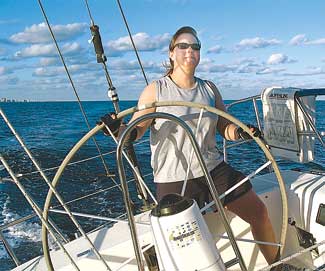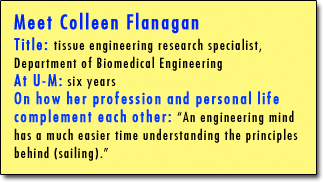While open seas and sterile labs may seem like polar opposites, Colleen Flanagan calls both of them home.
Flanagan, a tissue engineering research specialist who works on tissue scaffolding in the Department of Biomedical Engineering, finds time to sail in some of the greatest races of the continent.

It was while working as a graduate student research assistant in Steve Goldstein’s orthopedic research lab that Flanagan was introduced to the sport.
“While in the (orthopedic research) lab, I met people who were involved with a competitive sailing team on Lake St. Clair, and told me that the boats are always looking for new crew members,” she says. Interested, she went out on the boat, and loved it.
“I became completely addicted to sailing,” she says. “It was phenomenal.”
Flanagan, who earned undergraduate degrees in mechanical engineering and engineering science from U-M, left Ann Arbor in 1997 after earning her master’s degree in biomedical engineering to be a research fellow at the University of Pennsylvania. But she returned in January 2002 to work in Dr. Scott Hollister’s tissue engineering lab, and she resumed her sailing habits.
Sailing would lead her to Carinthia, a J/120 vessel owned by Frank Kern III. The crew of the Carinthia competes in the 214-nautical mile Bayview Mackinac Race, in which Flanagan has completed 12 times and most recently won in 2007. “Not only did we win for our class, but we also won overall, and that has to be one of my greatest sailing accomplishments,” Flanagan says.
The year 2007 was a successful one for Flanagan and the Carinthia crew. The boat competed in the 2007 Pineapple Cup — Montego Bay Race, a four-day, 811-nautical mile competition starting from Port Everglades, Fla., around the eastern tip of Cuba, and ending in Montego Bay, Jamaica.
“Our strategy that year was to run the boat on seven people instead of nine or 10 people,” she says, “so that there was less weight from the crew, our food, our clothes … It was hard to do, being short-staffed, but we managed.”

They won that event with the only woman to compete in the race that year — Flanagan. She also represented the lower Great Lakes area this past year in the U.S. Women’s Sailboat Championship in San Diego.
“I’m usually dealing with trimming the sails and choreographing sail changes or maneuvers on the boat,” she says, “but we rotate jobs around to keep everyone fresh and to keep the boat moving as fast as possible.”
Flanagan’s engineering skills come in handy both at sea and on shore.
In Hollister’s lab, Flanagan and her team focus on analyzing the role particular factors play in tissue growth and making the scaffolds where tissues will grow. The frames that they design will help replace bone, cartilage, vascular and heart valve tissues, among others.
One of her main projects is designing a scaffold for use in re-growing bone tissue in the cervical vertebrae. The idea is to make the body grow tissue around the scaffold using a protein delivered in collagen sponges. While this isn’t uncommon, “all of the other products use a system that isn’t biodegradable within the body, which is how ours is different,” she says.
There are many parallels between engineering and sailing, Flanagan says. “I usually do sail trim, because the job entails someone to get the best air-flow out of the sail so that the boat can go faster,” she says. “An engineering mind has a much easier time understanding the principles behind it.”
The weekly Spotlight features staff members at the University. To nominate a candidate, please contact the Record staff at [email protected].

